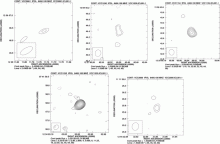
Abstract
We present the results of a 8.4 GHz Very Large Array radio survey of early-type galaxies extracted from the sample selected by Cote and collaborators for the Advanced Camera for Survey Virgo Cluster Survey. The aim of this survey is to investigate the origin of radio emission in early-type galaxies and its link with the host properties in an unexplored territory toward the lowest levels of both radio and optical luminosities.
Radio images, available for all 63 galaxies with B_T < 14.4, show the presence of a compact radio source in 12 objects, with fluxes spanning from 0.13 to 2700 mJy. The
remaining 51 galaxies are undetected at a flux limit of ~0.1 mJy. The fraction of radio-detected galaxies are a strong function of stellar mass, in agreement with previous results:
none of the 30 galaxies with M_* < 1.7 x 10^{10} solar masses is detected, while 8 of the 11 most massive galaxies have radio cores. There appears to be no simple relation between the presence of a stellar nucleus and radio emission. In fact, we find radio sources associated with two nucleated galaxies, but the majority of nucleated objects are not
a radio emitter above our detection threshold